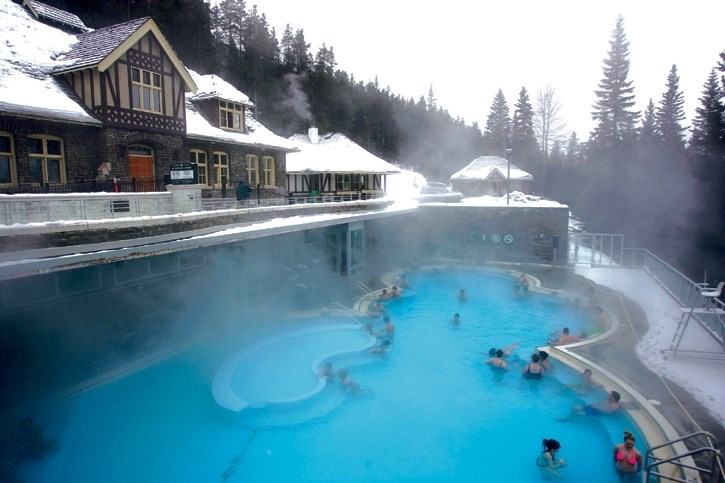BANFF – The Town of Banff’s elected officials are lobbying Parks Canada to help deal with the national park community’s traffic chaos and congestion by next year’s busy summer season, particularly to two major tourist attractions on Sulphur Mountain.
Council has directed administration to work with the federal agency to develop methods for implementation by summer 2025 to discourage people from driving personal vehicles to the Upper Hot Springs, operated by Parks Canada, and the Banff Gondola, owned and operated by American firm VIAD through its subsidiary Pursuit.
Coun. Chip Olver said that could include closing the parking lot at the two popular tourist attractions on Sulphur Mountain, except for buses and vehicles with handicap placards, or introducing paid parking there, and consideration of a parking reservation system in town.
“I would like to see the same creativity that dealt with some parking and traffic solutions in Lake Louise and Moraine Lake brought to the situation in Banff … to help resolve some of the traffic problems,” she said.
“Part of the conversation is around are people in Banff ready for something like this, I’d say, ‘yes we are’ … We have two major attractions outside the town boundary, but the only way to access them is through the townsite and we have to work with Parks on a solution.”
In Lake Louise, Parks Canada has introduced paid parking at Upper Lake Louise, charging $36.75 per vehicle per day in an attempt to encourage visitors to take transit from the park-and-ride lot at the ski hill.
In addition, the federal agency has closed Moraine Lake Road to private vehicles, allowing only transit and licensed private commercial companies to take the road to the iconic lake.
For Olver and some other councillors, the time has come for similar measures in Banff, which can see more than 30,000 vehicles per day on a busy summer day.
On the August long weekend, main entrance vehicle volumes were close to 118,000 in the four-square-kilometre community.
Olver said it is time to move beyond education and marketing to visitors to choose transit over personal vehicles.
“Now we’re entering the realm of paid parking, we’re entering the realm of parking reservations, we’re entering the realm of the parking lot being closed, except buses or people with handicap placards,” she said.
Banff National Park has seen a 30 per cent overall increase in vehicle traffic over the last decade and an explosion in visitation to approximately 4.2 million visitors a year.
The 2022 management plan for Banff National Park calls for development of a comprehensive people-movement plan for the park by 2024, but Parks Canada officials say that has been moved backed as the COVID-19 pandemic pushed back many deadlines in the plan.
The plan would consider local, regional, municipal and private transportation offers, existing pathways and trails, key attractions, and current and projected levels and patterns of visitor use.
“The timelines in the park management plan – including Moving People Plan development – have been extended to account for delays caused by the pandemic,” said Natalie Fay, external relations manager for Banff National Park field unit.
“The current park management plan was originally scheduled for approval in 2020, but was actually only approved and tabled in parliament in 2022. This is why timelines have had to be adjusted. Having said that, Parks Canada is working on this management plan commitment.”
Town Manager Kelly Gibson said administration has had many conversations with the Banff National Park field unit on ways to deal with the Town of Banff’s traffic woes.
He said administration continues to work on education and marketing, particularly in Calgary, to discourage personal use of vehicles and encourage transit to Sulphur Mountain.
“We’ve had multiple discussions with Parks Canada about paid parking up there. We’ve offered resources,” he said.
“We will continue every chance we get to see what we can do for the upcoming year.”
Coun. Grant Canning said clarity is needed once and for all from Parks Canada around visitor and vehicle use management strategies within and adjacent to the Banff townsite following years of discussions.
He said traffic management and congestion is not just a Town of Banff issue, but is also a Parks Canada matter.
“For way too long the Town of Banff has been asked to look at this issue in isolation, with no input directed from Parks Canada,” he said.
“That continues to be a massive problem because I think we’ve done everything we can within our four square kilometres to deal with these issues.”
Canning, who is a member of the Banff Community Plan steering committee, said the group has discussed concepts such as carrying capacity.
“To this point, we haven’t gotten into specific tactics around that,” he said.
In the meantime, council has also directed administration to come up with options for management of residential areas by discouraging visitors and commercial traffic from entering or travelling through residential neighbourhoods.
Canning said this was clearly one of the big points that came out of the pedestrian zone discussions and vote.
“I think there’s real concerns in the community around encroachment and visitors, and particularly vehicles, going through residential neighbourhoods,” he said.
“It’s very important to realize these are public roadways, these are public sidewalks, and we can’t prevent people from using them, but with that said, maybe there are some things we can do that could change behaviour or encourage a different behaviour.”
With closure of the pedestrian zone after the September Labour Day long weekend on Sept. 3 following the results of a binding vote of the electorate that showed 1,328 votes against the pedestrian zone and 1,194 in support, Canning said he hopes this will address some of the concerns in residential areas until other solutions can be also be considered.
“I don’t know what that looks like, but I defer to administration at service review with perhaps options and suggestions of what can be done,” he said.




